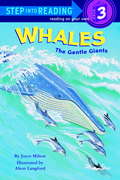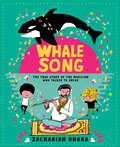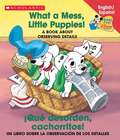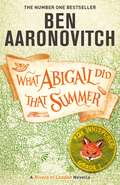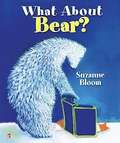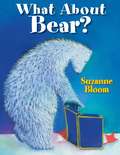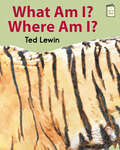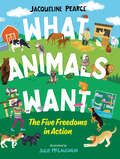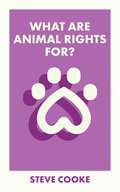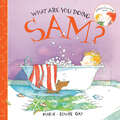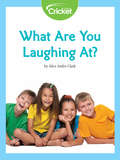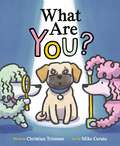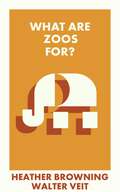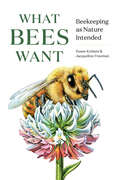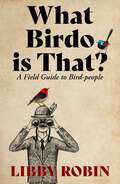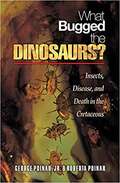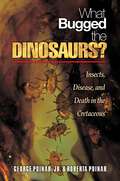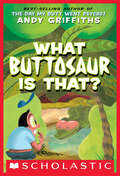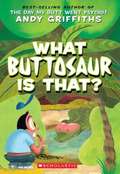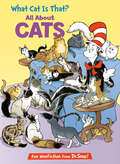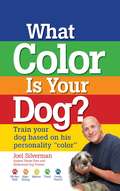- Table View
- List View
Whales: An Illustrated Celebration
by Kelsey OseidA gorgeously illustrated, entertaining, and educational guide to the wonderful whales, dolphins, and porpoises of the world.Some of the world's most fascinating and beloved animals, cetaceans have captivated the human imagination for centuries. Whales: An Illustrated Celebration explores the most interesting and illuminating facts about these marine mammals, from the enormous blue whale (which has a heart the size of a car!) to the Amazon river dolphin (which is pink!). Gorgeously illustrated with full-color art on every page, this giftable guide delves into cetaceans' mysterious evolution (from land to water mammals), their place in mythology, and their ecology, habitats, and behaviors (such as singing, fluking, beaching, bubble feeding, and more). Perfect for nature and animal lovers from eight to eighty, Whales also covers the current state of wild and captive cetaceans worldwide, why we should care, and what we can do to help our beautiful marine mammal friends.
Whales: The Gentle Giants (Step into Reading)
by Joyce MiltonIllus. in full color. "Milton understands what kids like about whales, and packs a considerable amount of information into the book. This easy-reader leaps with appeal."--Bulletin, Center for Children's Books.
Whalesong: The True Story of the Musician Who Talked to Orcas
by Zachariah OHoraA captivating informational picture book about Paul Horn, a musician who communicated with orcas through the power of music. For fans of Shark Lady and Margaret and the Moon.Unbelievable but true, this is the story of two whales, two Pauls and two boys.The whales are Haida and Chimo, captive orcas who lived in an aquarium called Sealand of the Pacific in the 1970s.The Pauls are Paul Horn, a professional flute musician, and Dr. Paul Spong, a scientist studying the orcas in order to learn more about these mystifying creatures.And the boys are Marlen and Robin, Paul Horn's sons, who are fascinated with the orcas despite their father's fear of the giant whales.What follows is the spellbinding story of how the Pauls, through the power of music, learn to communicate with the orcas — and set into motion an entire anti-captivity movement dedicated to protecting these intelligent and majestic animals.
Whaling Season: A Year in the Life of An Arctic Whale Scientist (Scientists in the Field)
by Peter LourieIt's late April in Barrow, Alaska, which is about as far north in Alaska as you can get. The call comes in over the two-way radio - a crew has caught the first whale of the spring whaling season. Men, women, and teenagers jump on snow machines and drive out onto the ice to help harvest the whale, a tradition the Inupiaq Eskimos on Alaska's North Slope have followed for over two thousand years. John Craighead George, or Craig as he's called, heads out too. He is an Arctic whale scientist, and out on the ice with the whales and the whalers is just one of the places where an Arctic whale scientist works. <p><p> He and his colleagues have an agreement with the Inupiat to study these whales, bowheads. He has studied them for nearly thirty years and the mysteries of these large creatures never fail to amaze him. This installment in the Scientists in the Field series takes readers along with Craig, his wife, their colleages, and the Inupiat people as they go out on the ice and harvest whales. Lourie also details the happenings in Craig's ramshackle lab where he studies various organs and body parts, takes careful measurements, and crunches numbers. This is a real profile of what it is like to be a scientist living where he works, harvesting his own subjects, and using information passed down from generations of Eskimo culture to help him as he becomes the world's leading expert on bowhead whales. <p><p> Craig George is the son of legendary children's author Jean Craighead George, and it is easy to see that Craig grew up in a household where nature and human interaction went hand in hand. Author Pete Lourie's stunning photographs will transport readers to the top of the world, where the days and nights are long, the people respectful, and the whales are at the center of it all.
What A Mess, Little Puppies! / Vaya Desorden, Cachorritos!
by Macarena SalasBig news: Baby's First Disney Books are now bilingual! It's easier, and more fun,- than ever for the adorable Disney Babies characters to teach your baby about shapes, colors, letters and other important early-learning concepts. Filled with fun Disney adventures, the bright, colorful board books are simply irresistible to baby. Each one features short, simple sentences that are repeated in both English and Spanish to help make learning easier. Plus, the sturdy pages with rounded corners help keep your little one safe!
What Abigail Did That Summer: A Rivers Of London Novella
by Ben AaronovitchThe brand new novella in the much-loved and #1 bestselling Rivers of London series!Ghost hunter, fox whisperer, troublemaker.It is the summer of 2013 and Abigail Kamara has been left to her own devices. This might, by those who know her, be considered a mistake. While her cousin, police constable and apprentice wizard Peter Grant, is off in the sticks chasing unicorns, Abigail is chasing her own mystery. Teenagers around Hampstead Heath have been going missing but before the police can get fully engaged, the teens return home - unharmed but vague about where they've been.Aided only by her new friend Simon, her knowledge that magic is real, and a posse of talking foxes that think they're spies, Abigail must venture into the wilds of Hampstead to discover who is luring the teenagers and more importantly - why?* * * * *PRAISE FOR THE BESTSELLING RIVERS OF LONDON SERIES'Highly entertaining' Sunday Express'Funny and wildly inventive' Mail on Sunday'Masterfully crafted ... gives the late, great Terry Pratchett a run for his money' The Sun'Ben Aaronovitch has created a wonderful world full of mystery, magic and fantastic characters. I love being there even more than the real London.' Nick Frost'Charming, witty, exciting' Independent'An incredibly fast-moving magical joyride for grown-ups' The Times
What About Bear? (Goose And Bear Stories)
by Suzanne BloomWhen a squirrel joins the duck and the bear for playtime, one of them is left out and someone must figure out how all three of them can play together.
What Am I? Where Am I? (I Like to Read)
by Ted LewinMajestic paintings by Caldecott Honor winner Ted Lewin illustrate a guessing game that fosters an appreciation of both art and science, while introducing animals in the five major biomes: grassland, desert, forest, tundra, and water. Inspired by his many travels, classically inspired compositions communicate the regal magnificence of five stunning animals: lion, camel, tiger, reindeer, and sea otter. The story ends with a painting of a child and text that reads: I am a boy. I am on the beautiful earth. An I LIke to Read(R) book. Guided Reading Level C.
What Animals Want: The Five Freedoms in Action (Orca Think #3)
by Jacqueline PearceAll animals need food, water and shelter. But what about their social and emotional needs? Modern science tells us that animals experience a wide range of emotions—from fear and anxiety to friendship and happiness. What Animals Want is an animal-care book with a difference. It introduces young readers to the Five Freedoms and helps them think about their pets’ physical and emotional needs, providing a framework for thinking about the welfare of all animals in human care, including farm, exotic and wild animals. Author Jacqueline Pearce wrote this book in consultation with the British Columbia Society for the Prevention of Cruelty to Animals (BC SPCA), an organization internationally recognized for its innovative humane education and animal welfare work.
What Are Animal Rights For?
by Steve CookeHow should we treat animals? The long-held belief that other animals exist solely for human use has undergone radical challenge in the past half century. How much further do we need to go to minimize, and even eliminate, animal suffering? The field of animal rights raises big questions about how humans treat the other animals with which we share the planet. These questions are becoming more pressing as livestock farming exerts an ever-greater toll on the planet and the animals themselves, and we learn more about their capacity to think and experience pain. This book shows why animals ought to have greater rights and what the world might look like if they did.
What Are We Even Doing With Our Lives?: The Most Honest Children's Book of All Time(Apple FF)
by Mary Dauterman Chelsea MarshallNamed one of the best comedy books of 2017 by Splitsider.comIn this a charming, satirical "children’s" book, BuzzFeed’s lead animal editor and an acclaimed art director/illustrator poke fun at our contemporary, hyper-connected, and often mundane millennial age and the absurdities of the #blessed time and place in which we all now live.Welcome to "Digi Valley," the epitome of twenty-first-century urban life! The animal-people who call it home do cool things: life coach, cat landlord, baby DJ teacher, app developer, iPhone photographer, new media consultant, beauty blogger, and, of course, freelancer. On the street, in the coffee shop, at the farmer’s market, or the local vegan café, you’ll meet new friends like Frances and Sadie, Freelance Frank, Realtor Rick, and Bethany the Beauty Blogger as they bike, drive, bus, hoverboard, and Uber their way around town—or just sit and enjoy a latte while doing important things on their devices. Everybody in Digi Valley is very, very busy—texting, tweeting, video chatting, sending selfies, swiping for dates, and binging on their favorite shows. Whether you’re looking for a job at the latest media startup or want to publish your own web series, this urban mecca has something for everyone. And with the emotionally sensitive, tech-friendly Digi Valley Elementary School, it’s a great place to raise kids too!In What Are We Even Doing With Our Lives? Chelsea Marshall and Mary Dauterman have created an authentic fictional world that illuminates the funny, silly, earnest experience of millennial life. But watch out when the unthinkable happens—the internet goes down! Filled with dozens of illustrated spreads, What Are We Even Doing With Our Lives? is the most honest children’s book for all ages ever written... like seriously.
What Are You Doing, Sam? (Stella And Sam Ser.)
by Marie-Louise Gay"What are you doing, Sam?" calls Stella.Sam and his dog, Fred, are creating joyful havoc throughout the house. Be it snorkeling in the bathtub, teaching Fred to read or roll over, or cooking up a pancake feast, they are having a marvelous time. Of course, Stella joins in the fun as she observes the inventive antics of Sam and his beloved companion.In this wonderful addition to the Stella and Sam series, Marie-Louise Gay has created another charming picture book. Delicate watercolors, full of expression and humor, bring her delightful story to life.
What Are You Laughing at?
by Alice Andre-ClarkHumans are such experts at laughing that we can distinguish a fake laugh from a real one. But why do we laugh?
What Are You?
by Christian TrimmerFrom Christian Trimmer and award-winning illustrator Mike Curato comes What Are You?, a brilliant, new early-reader picture book brimming with warmth and playfulness that explores questions of race and identity. When a puggle meets two new poodle friends, there is a question the poodles feel they must ask. What are you? What am I?Yes, what are you? I am a dog.No, what are you?So begins a conversation about family and identity, and about the things we're good at... and why we're good at them.Brimming with warmth and playfulness, What Are You? is an exemplary picture book for early readers. Equally funny and thoughtful, the book includes prompts to facilitate important first conversations about stereotypes and bias between child and adult.
What Are Zoos For? (What Is It For?)
by Walter Veit Heather BrowningAre zoos an anachronism in the 21st century when we can watch animals in their natural habitat, close-up from our couches without worrying about cruelty? Should they go the way of other bygone era ‘spectacles’ and ‘attractions’ that we now regard as barbaric? There are vocal campaigners and activists who believe so. Heather Browning and Walter Veit disagree, but they acknowledge there is a case to be answered. In What are Zoos for? they test the common justifications for zoos (entertainment, education, research, conservation) against the evidence and suggest what the best zoos of the future should look like to ensure that they are primarily for animals and not just for people.
What Bees Want: Beekeeping as Nature Intended
by Susan Knilans Jacqueline FreemanBee populations are plummeting. The solution? Give them what they need to live naturally, and they’ll handle the rest. Susan Knilans and Jacqueline Freeman are in love with bees. So in love that they observe their bees—their work, communication, seasonal activity, and more—for hours each day. And with observation came realization: when bees are allowed to live as they would in nature (with smaller hives, no chemicals, freedom to swarm, and little-to-no human interference), they will thrive. Accordingly, Knilans and Freeman have spent decades perfecting the revolutionary practice of preservation beekeeping, guided by the simple question, “What do the bees want?” A surprising page-turner, this instructional book tells the story of their successes and failures, demonstrating what was learned along the way. Sharing preservation beekeeping’s key tenets, the authors provide concrete, simple ways to implement their approach, from finding the right hive location to honing observation skills. This preservation manifesto is a vital addition to any beekeeper’s library, imparting all the joys of a beekeeper's life.
What Birdo is that?: A Field Guide to Bird-people
by Libby RobinThe idea that a bird is good news and needs all our support is probably the only thing amateur birdos, professional zoologists and 'birdscapers'-people who redesign their gardens to support birdlife-have in common. But together they form a conservation community that cares about the future of birds and their habitats, who are working to heal the damage wrought by those who don't notice birds. What Birdo is That? reveals how bird-people in Australia have gone about their craft across the years. Its stories come from wild places - at sea as well as on the land-from dusty archives, from restoration projects, gardens and urban wastelands. They are human stories, but the birds themselves interject and interrupt any self-important anthropocentrism. They educate. They counter the imperialism of the ever-expanding economies of the new millennium. They turn up in unexpected places, giving surprise and joy. This field guide to Australia's bird-people provides a basis for understanding the complex relationship between people and birds in a land of extremes at the forefront of changing climate and habitats.
What Bugged the Dinosaurs?: Insects, Disease, and Death in the Cretaceous
by Roberta Poinar George O. PoinarMillions of years ago in the Cretaceous period, the mighty Tyrannosaurus rex--with its dagger-like teeth for tearing its prey to ribbons--was undoubtedly the fiercest carnivore to roam the Earth. Yet as What Bugged the Dinosaurs? reveals, T. rex was not the only killer. George and Roberta Poinar show how insects--from biting sand flies to disease-causing parasites--dominated life on the planet and played a significant role in the life and death of the dinosaurs. <p><p> The Poinars bring the age of the dinosaurs marvelously to life. Analyzing exotic insects fossilized in Cretaceous amber at three major deposits in Lebanon, Burma, and Canada, they reconstruct the complex ecology of a hostile prehistoric world inhabited by voracious swarms of insects. The Poinars draw upon tantalizing new evidence from their amazing discoveries of disease-producing vertebrate pathogens in Cretaceous blood-sucking flies, as well as intestinal worms and protozoa found in fossilized dinosaur excrement, to provide a unique view of how insects infected with malaria, leishmania, and other pathogens, together with intestinal parasites, could have devastated dinosaur populations. <p><p> A scientific adventure story from the authors whose research inspired Jurassic Park, What Bugged the Dinosaurs? offers compelling evidence of how insects directly and indirectly contributed to the dinosaurs' demise.
What Bugged the Dinosaurs?: Insects, Disease, and Death in the Cretaceous
by Roberta Poinar George PoinarMillions of years ago in the Cretaceous period, the mighty Tyrannosaurus rex--with its dagger-like teeth for tearing its prey to ribbons--was undoubtedly the fiercest carnivore to roam the Earth. Yet as What Bugged the Dinosaurs? reveals, T. rex was not the only killer. George and Roberta Poinar show how insects--from biting sand flies to disease-causing parasites--dominated life on the planet and played a significant role in the life and death of the dinosaurs. The Poinars bring the age of the dinosaurs marvelously to life. Analyzing exotic insects fossilized in Cretaceous amber at three major deposits in Lebanon, Burma, and Canada, they reconstruct the complex ecology of a hostile prehistoric world inhabited by voracious swarms of insects. The Poinars draw upon tantalizing new evidence from their amazing discoveries of disease-producing vertebrate pathogens in Cretaceous blood-sucking flies, as well as intestinal worms and protozoa found in fossilized dinosaur excrement, to provide a unique view of how insects infected with malaria, leishmania, and other pathogens, together with intestinal parasites, could have devastated dinosaur populations. A scientific adventure story from the authors whose research inspired Jurassic Park, What Bugged the Dinosaurs?? offers compelling evidence of how insects directly and indirectly contributed to the dinosaurs' demise.
What Buttosaur Is That? (Andy Griffiths' Butt Series)
by Andy GriffithsFrom the New York Times–bestselling author of the Butt Trilogy comes a silly and informative look at prehistoric butt-related life forms.Tyrannosore-arse Rex versus Tricerabutt: Who kicked more butt?Stenchtiles and Farthropods: Which smelled most foul?Exstinktion: How did the buttosaurs get wiped?This book will tell you everything you need to know but were too grossed out to ask about prehistoric butt-related life forms and the complex stenchology of their environment. Never again will you look like a fool when somebody asks, “What buttosaur is that?”A must-have for every kid with a butt!
What Buttosaur Is That? (Butts #4)
by Andy GriffithsTyrannosore-arse Rex versus Tricerabutt: Who kicked more butt? Stenchtiles and Farthropods: Which smelled most foul? Exstinktion: How did the buttosaurs get wiped? This book will tell you everything you need to know but were too grossed out to ask about prehistoric butt-related life forms and the complex stenchology of their environment. Never again will you look like a fool when somebody asks, "What buttosaur is that?" A must-have for every kid with a butt!
What Cat Is That? All About Cats: All About Cats (The Cat in the Hat's Learning Library)
by Tish RabeLaugh and learn with fun facts about cats, from domestic to wild, kittens to cubs, and more—all told in Dr. Seuss&’s beloved rhyming style and starring the Cat in the Hat! &“I&’m the Cat in the Hat. Let us leave right away to see all the cats we can see in one day.&” The Cat in the Hat&’s Learning Library series combines beloved characters, engaging rhymes, and Seussian illustrations to introduce children to non-fiction topics from the real world! Travel aboard the Kitty-Cat-Copter and learn: • how cats fit through small spaces• how they use their whiskers• why their eyes glow in the dark• and much more! Perfect for story time and for the youngest readers, What Cat Is That? All About Cats also includes an index, glossary, and suggestions for further learning. Look for more books in the Cat in the Hat&’s Learning Library series!If I Ran the Horse Show: All About HorsesClam-I-Am! All About the BeachMiles and Miles of Reptiles: All About ReptilesA Whale of a Tale! All About Porpoises, Dolphins, and WhalesSafari, So Good! All About African WildlifeThere's a Map on My Lap! All About MapsOh, the Lavas That Flow! All About VolcanoesOut of Sight Till Tonight! All About Nocturnal AnimalsOnce upon a Mastodon: All About Prehistoric MammalsOh Say Can You Say What's the Weather Today? All About WeatherThe Cat on the Mat: All About Mindfulness
What Color Is Camouflage?
by Carolyn B. OttoWhat do a fawn and a hermit crab have in common? They both use camouflage to hide from their enemies. A fawn's spots help it blend in with its dappled surroundings, and a hermit crab might be mistaken for an empty shell. This lyrical introduction to camouflage explains how and why a wide variety of animals use it to go undercover. Readers can also hunt for camouflaged animals in every illustration.
What Color Is Your Dog?
by Joel SilvermanThis exciting dog training book is based on the original techniques of Hollywood dog trainer and Animal Planet's Good Dog U host, Joel Silverman. In What Color Is Your Dog? Silverman presents his groundbreaking color-coding technique, developed over his thirty-year career training dogs for film, television, and commercials as well as working with killer whales in Sea World. By determining what color is an owner's dog, he is able to recognize and then enhance his dog's behavior, following the techniques outlined in the book.Silverman's advice for new puppy owners is to develop a strong, trusting relationship with their puppies in their first thirty days. He shuns traditional concepts of beginning the puppy's lessons as soon as the puppy comes home; instead he proposes that new owners spend time having fun, building trust, and enjoying the first month of the relationship. By increasing the dog's trust and "like" of his owner, the dog becomes more willing and eager to please and work with his owner/trainer.The main gist of the book comes from Silverman's color system in which five basic canine personalities or temperaments are assigned colors. With the descriptions of the five colors in hand-Blue (a fearful, rather skittish type dog), Green (a more or less bashful pooch), Yellow (the ideal, easygoing companion dog), Orange (excitable, but relatively under control dog), and Red (the hyper, high-strung dog that bounces off the walks as soon as bark)-an owner is able to determine which color best matches his dog's temperament and approach the dog's lessons accordingly. The dog owner's goal then is to move his dog as close to the middle of the color spectrum (Yellow) as possible by using the training practices outlined in the book.Silverman devotes a full chapter to each of the five colors, explaining what makes each color type tick and how owners should best handle such a dog.The second half of the book focuses on training tools and techniques and teaching specific cues (sit/stay, stay, come, and no). There is also a chapter for the puppy owner giving helpful advice on special techniques to use for puppies.

